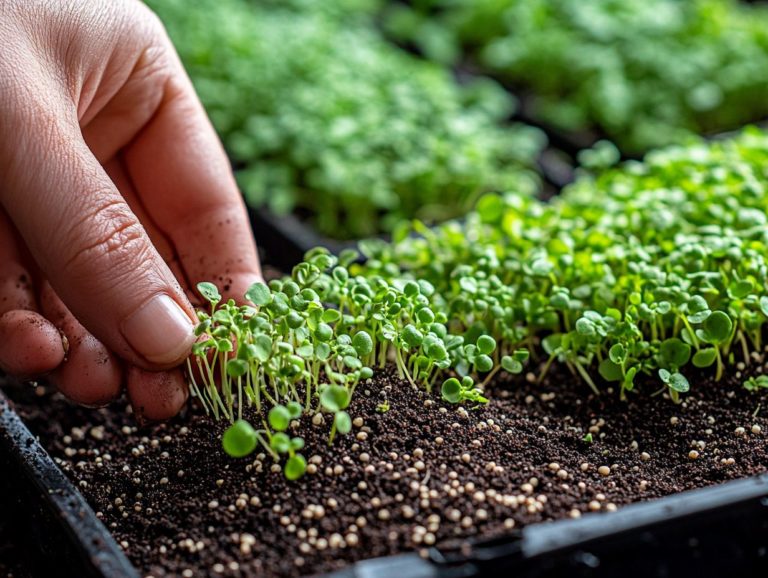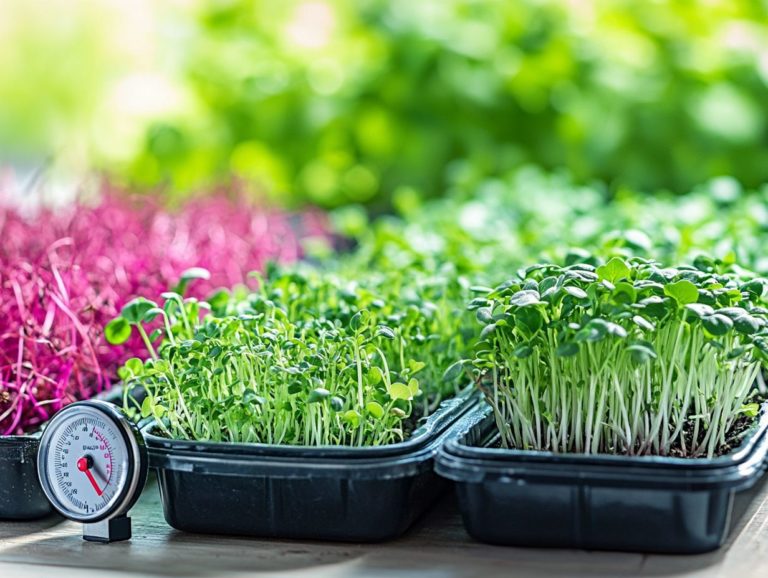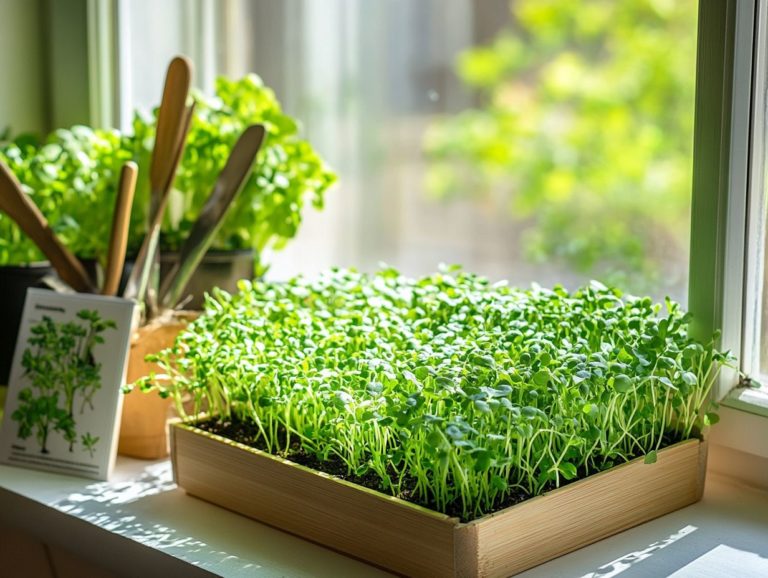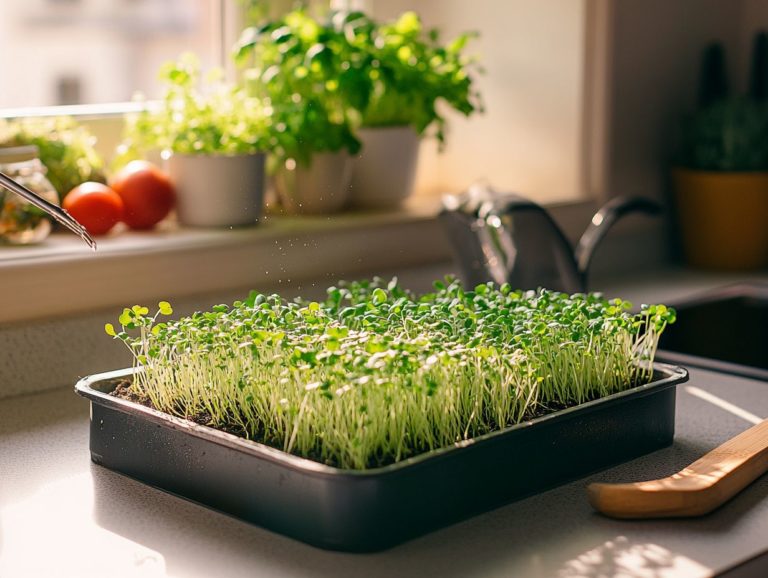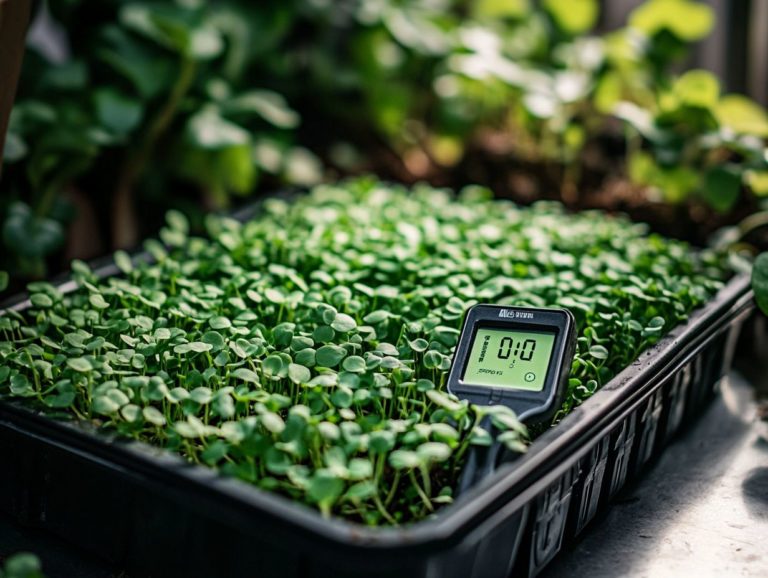The Benefits of Growing Microgreens Vertically
Microgreens have captivated the culinary scene, delivering an impressive punch of flavor and nutrition in a compact form.
By opting for vertical growing methods, you can significantly enhance your gardening success. This article dives into the remarkable benefits of cultivating microgreens vertically, showcasing its space efficiency, increased yield, and reduced risk of pests and diseases.
You’ll find invaluable guidance on setting up your vertical garden, discovering the best varieties to grow, and receiving expert tips for harvesting and incorporating these vibrant greens into your meals.
Get ready to take your gardening to the next level!
Contents
Key Takeaways:

- Grow microgreens vertically to save space and maximize yield.
- Vertical growing lowers the risk of pests and diseases for healthier and cleaner microgreens.
- Harvest and use microgreens creatively in cooking for added flavor and nutritional benefits.
What are Microgreens?
Microgreens are delightful young plants harvested at the seedling stage typically within a mere 7 to 21 days after germination. Known for their vibrant colors and intense flavors, they re grown in controlled environments, often using a method where plants grow in water instead of soil. This makes them a favored choice among urban farming initiatives that emphasize resource efficiency and sustainable agriculture.
These petite greens, including varieties such as arugula, radish, and basil, are packed with concentrated nutrition. They often have higher levels of vitamins, minerals, and antioxidants than their mature counterparts. The cultivation methods ensure maximum growth while significantly reducing the use of pesticides and fertilizers, aligning perfectly with eco-friendly farming practices.
Microgreens contribute immensely to local food systems. Because they can be grown year-round in limited spaces, they help cut down on transportation emissions and provide fresh produce right in the heart of urban areas. As awareness of the health benefits of growing your own microgreens rises, gourmet chefs and health enthusiasts alike eagerly incorporate them into various dishes, elevating both flavor and nutritional value.
Advantages of Growing Microgreens Vertically
Growing microgreens vertically offers numerous advantages, especially in urban environments where conventional land is limited. This innovative approach boosts crop yield through advanced farming technology and promotes resource efficiency within a controlled setting.
Space Efficiency
Space efficiency is a primary advantage of vertical farming, enabling you to cultivate microgreens in limited urban spaces while maximizing production capabilities through vertical systems instead of traditional horizontal layouts.
Vertical farms can produce up to ten times more food per square foot compared to conventional methods. This makes them particularly suited for densely populated areas where land is a precious commodity. For example, a successful initiative in Brooklyn, New York, has shown how just 30,000 square feet can yield the equivalent of ten acres of traditional farmland.
This innovative method conserves valuable urban real estate, slashes transportation costs, enhances food security, and minimizes the carbon footprint associated with agricultural practices. As urban environments continue to expand, the adaptability of vertical systems becomes increasingly crucial for sustainable agriculture in cities.
Start your vertical garden today and discover the joy of growing your own microgreens!
Increased Yield
Vertical farming dramatically enhances crop yield, especially for microgreens, by leveraging cutting-edge hydroponics and agricultural technology that create ideal growing conditions within a controlled environment.
This groundbreaking approach employs precise nutrient delivery systems, ensuring that each plant receives the perfect blend of essential minerals and vitamins. For example, a study from the University of Controlled Agriculture revealed that crops cultivated in vertical systems can yield up to ten times more than those grown in traditional fields. Additionally, incorporating practices like growing microgreens offers numerous benefits for both health and sustainability.
By implementing techniques such as aeroponics and LED lighting, vertical farms can extend growing seasons and reduce water usage by as much as 90%. These scientific principles harness the power of photosynthesis in compact spaces, transforming urban landscapes into thriving agricultural hubs.
Reduced Pests and Diseases

Imagine growing vibrant microgreens with fewer pests and diseases! This method offers fantastic benefits, particularly in reducing pests and diseases. By implementing effective pest management strategies, you enhance food safety and ensure healthier crops.
This method allows you to maintain careful control of the climate, creating optimal growing conditions. You can also incorporate various organic approaches, such as companion planting and beneficial insects, to create a thriving ecosystem. By fostering this balance, you naturally minimize the threat of harmful pests, which reduces the need for chemical interventions that could compromise food safety.
Urban farming initiatives greatly benefit from these practices, providing a sustainable model for producing fresh produce while mitigating health risks often associated with traditional agriculture. Ultimately, utilizing controlled environments enables you to consistently produce high-quality microgreens while contributing to the well-being of the larger community.
How to Grow Microgreens Vertically
Growing microgreens vertically demands careful selection of materials and a well-thought-out setup to create optimal conditions for their growth. This is especially true when employing hydroponics a method of growing plants without soil, using nutrient-rich water instead within a vertical farming system, designed to maximize resource efficiency.
Materials and Setup
The materials you need for vertical microgreen farming include hydroponic systems, growing trays, nutrient solutions, and suitable lighting to ensure your plants thrive.
Hydroponic systems are the backbone of this innovative approach, creating a soil-less environment that promotes optimal root development and nutrient uptake. Growing trays are critical for organizing your microgreens in a vertical layout, allowing you to utilize space efficiently while maximizing light exposure. To learn more about the benefits, explore understanding the health benefits of microgreens.
Nutrient solutions are specially formulated blends that deliver essential minerals and vitamins directly to your plants, significantly boosting growth rates and overall quality.
Adequate lighting, often provided by energy-efficient LEDs, ensures that your microgreens receive the right spectrum for photosynthesis, which is crucial for their vitality and flavor.
Together, these components exemplify the synergy of farming technology and nutrient delivery, enabling you to cultivate vibrant, healthy crops throughout the year.
Step-by-Step Instructions
Step into the world of vertical microgreen cultivation with a clear set of instructions that will guide you through each essential phase: preparing your vertical systems, planting seeds, maintaining ideal climate conditions, and harvesting at the right moment for optimal crop yield.
These steps are pivotal in ensuring a bountiful harvest and can be easily adapted to meet a variety of space constraints, making vertical microgreens an appealing choice for both enthusiasts and commercial growers alike. Additionally, exploring the benefits of indoor microgreen growing can further enhance your gardening experience.
- Select the perfect vertical growing systems that maximize light exposure while minimizing your footprint; effective preparation of the growing medium significantly enhances seed germination.
- Once you’ve sown your seeds, focus on maintaining proper humidity levels and temperature, as microgreens flourish in warm, bright environments.
- Understand the optimal harvesting times varying between species to ensure that your final product is vibrant and bursting with flavor.
Try growing your own vertical microgreens today! Experience the joy of fresh, healthy produce right at home and contribute to a greener urban environment.
Best Types of Microgreens to Grow Vertically
Some of the finest microgreens for vertical cultivation include arugula, radish, and basil.
Each of these varieties not only brings distinct flavors to your culinary creations but also offers impressive health benefits, making them favorites among urban farmers.
Popular Varieties and Their Benefits

Popular microgreens like arugula, radish, and basil aren t just flavorful; they re also packed with essential nutrients, making them a great choice for health-conscious individuals.
These vibrant greens are rich in vitamins, minerals, and antioxidants that can enhance any diet. For instance, arugula is high in vitamin K, crucial for bone health. Radish microgreens provide a peppery kick and potential antioxidant benefits. Basil microgreens, with their delightful aroma, also support heart health thanks to their anti-inflammatory properties.
Moreover, these microgreens are incredibly versatile in the kitchen. They can elevate salads, add a gourmet touch as garnishes, or blend seamlessly into smoothies. This versatility enhances their appeal within sustainable food systems, encouraging the use of fresh, local produce while also offering hidden health benefits that further promote well-being.
Harvesting and Using Microgreens
Harvesting and utilizing microgreens involves techniques essential for ensuring their freshness and maximizing their nutritional benefits. It s vital to follow food safety practices to maintain the highest quality.
Tips for Harvesting and Storing
Proper harvesting and storing techniques are essential for maintaining the freshness and quality of your microgreens, ensuring they retain their nutritional value and meet food safety standards.
To achieve optimal results, knowing the right timing for harvesting is crucial. Cut the microgreens just above the soil line when they reach a height of two to three inches. Using clean, sharp scissors or a knife prevents damage or contamination.
Once harvested, store them in a breathable container to help sustain their crispness. Cooling your microgreens swiftly after harvest and maintaining a temperature between 32 F and 41 F enhances their shelf life and protects their nutritional content.
By following these best practices, you can enjoy vibrant, nutrient-rich greens for an extended period.
Creative Ways to Use Microgreens in Cooking
Microgreens can be creatively integrated into various dishes, elevating flavor while providing a nutritional boost. They are an incredibly versatile ingredient in modern cooking.
When added to salads, they offer a vibrant burst of color and a delightful range of tastes, transforming simple greens into a gourmet masterpiece. As garnishes, they do more than beautify your plates; they introduce unique flavors that complement or contrast with main ingredients.
Incorporating microgreens into your smoothies is a brilliant way to enrich your morning routine with vitamins and minerals, all without sacrificing taste. Their concentrated nutrients and robust flavors enable both home cooks and professional chefs to enhance their recipes with ease, showcasing the significance of these tiny plants in culinary creativity. To learn more about their cultivation, check out the best ways to grow and store microgreens.
Frequently Asked Questions
What is Eden Green Technology?
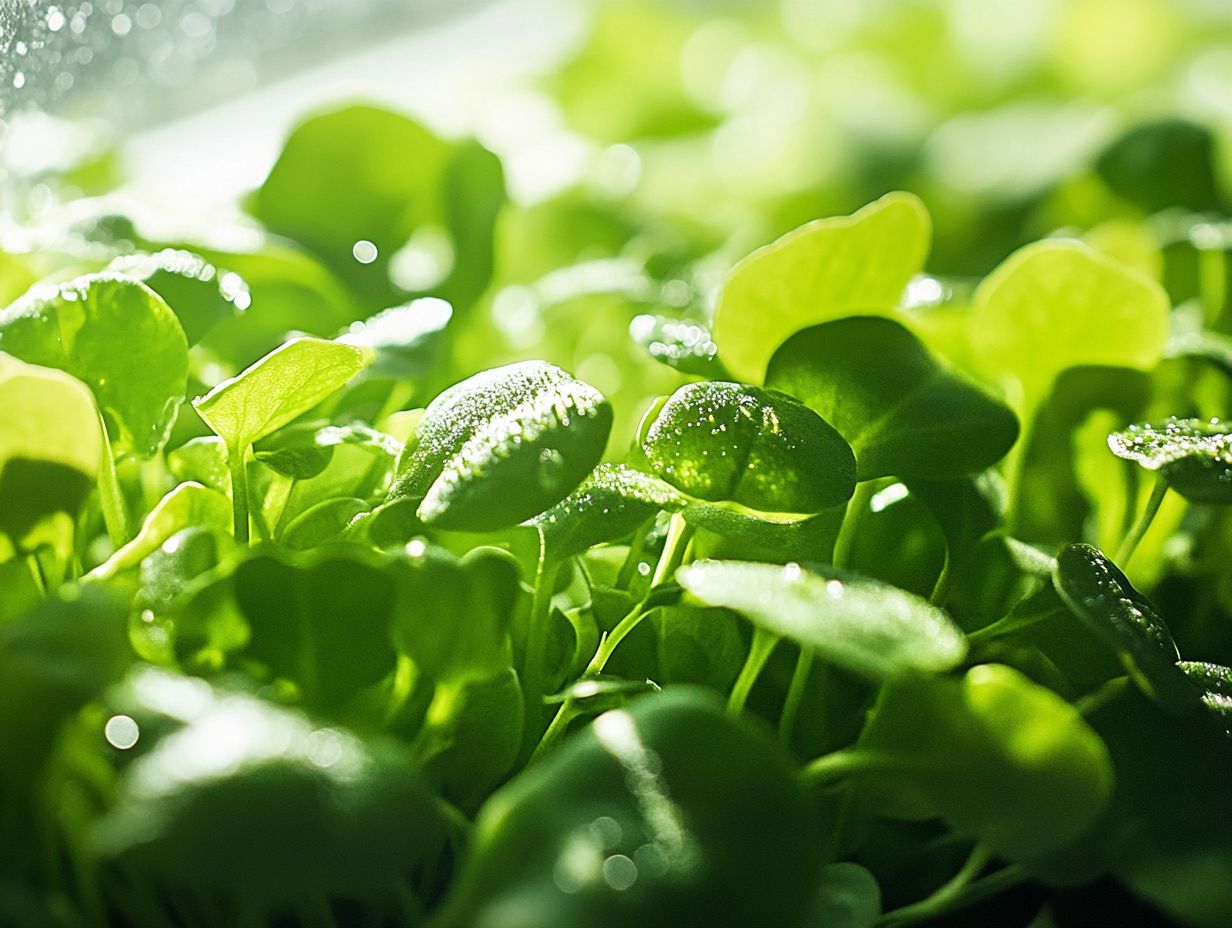
Eden Green Technology is a leader in controlled environment agriculture, providing innovative solutions for urban farming and increasing crop yield.
What are microgreens?
Microgreens are young, edible leafy greens harvested shortly after the first few leaves appear. They are smaller than baby greens but larger than sprouts, making them a nutritious addition to any diet.
Ready to grow your own microgreens? Start today and experience the difference they can make in your meals!
What is vertical growing?
Vertical growing uses structures like walls or shelves to cultivate plants. This modern approach maximizes space and enhances air circulation.
What are the benefits of growing microgreens vertically?
Growing microgreens vertically offers many benefits. It maximizes space, improves air circulation, and simplifies harvesting.
This method helps evenly distribute water and lowers the risk of pests and diseases.
What types of microgreens can be grown vertically?
You can grow many microgreens vertically, including kale, broccoli, and radish. Choose varieties that grow quickly and thrive in small spaces.
Do I need any special equipment to grow microgreens vertically?
While specialized systems exist, you can easily make your own with shelves, containers, and lights. Ensure you have good drainage, air circulation, and light.
What are the nutritional benefits of microgreens?
Microgreens are highly nutritious, offering more vitamins, minerals, and antioxidants than mature plants. They are a fantastic addition to a healthy diet!

